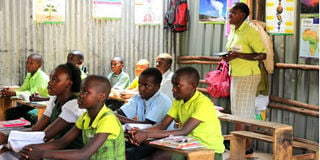International Day of the African Child: Empowering our leaders of tomorrow

A teacher in class at a Bridge International Academies school in Lunga Lunga, Nairobi.
What you need to know:
- In five to ten years Africa will provide about half of the world’s increase in the working-age population.
- On an economic level, the potential of embracing Africa’s youth population increase through education is clear.
The youth of today are the leaders of tomorrow. These are words that were spoken by Nelson Mandela, and they still ring true, eluding time and geopolitical context. For Africa, they resonate today more than ever before – because of our historic boom in the population of young people.
This International Day of the African Child, 16 June, is arguably the most significant on record. 2023 is set to be the year when Sub-Saharan Africa leads the world as the region with the most young people (0-14) – the size and acceleration of this age cohort are historically unprecedented.
But what does this shift really mean for Africa and the World? The answer to this question will depend on the action or inaction of leaders – to embrace an immense opportunity or let it slip by.
Investing in education is investing in the future, and with Sub-Saharan Africa certainly not lacking potential with its rapidly growing population of young people, prioritizing fruitful education systems is essential.
Unfortunately, this can be difficult, and as always barriers get in the way.
It is these education challenges that contribute to Learning Poverty – defined as the percentage of 10-year-olds unable to read a simple sentence – in Sub-Saharan Africa the rate of Learning Poverty is 90%.
The UN’s Sustainable Development Goals (SDGs) are at about the halfway point, the fourth goal, aiming to “ensure inclusive and equitable quality education and promote lifelong learning opportunities for all,” is clearly being missed in many Sub-Saharan African countries, despite considerable investment – highlighting the need for solutions that deliver outcomes.
On the continent there are some leading examples of education programs that go against the trend and transform learning outcomes. Bridge International Academies is delivering a vision and way forward for pupils to learn in a meaningful way. Bridge is successfully building holistic education systems through data-driven pedagogy, innovative learning technologies, and powerful school administration systems.
Education - the bedrock of human capital
In five to ten years Africa will provide about half of the world’s increase in the working-age population. Investing in future generations' learning will determine the skill set of these world’s shaping young people.
With the population of Sub-Saharan Africa skyrocketing, so does the demand for essential services like healthcare, infrastructure, and all the elements that create and maintain a prosperous society. Education is the foundation of these services and will provide a pathway for Africa’s young people to seize career opportunities.
On an economic level, the potential of embracing Africa’s youth population increase through education is clear. The World Bank estimates that one extra year of education correlates with 10 per cent higher household income, and one extra year on average for a country translates overall to 2.5 per cent higher GDP per capita.
Additionally, a study co-authored by the Yidan Prize winner Professor Eric Hanushek estimates the value of ensuring all students achieve global basic-level skills. In Sub-Saharan Africa 94 per cent of youth do not reach basic skill levels, heavily contributing to global levels, which have been estimated at present value to equate to a lost world economic output of more than $700 trillion over the remaining century – highlighting the alarming opportunity cost of not investing in African human capital.
Civil societal and social cohesion also heavily rest on education. When a young person lacks confidence in their education system and is unable to embrace learning, they are put at risk. Young people with poor education outcomes tend to have less economic prospects, locking them in a vulnerable position, and increasing their risk of becoming victims of vice, such as human trafficking – something many African governments battle with.
With more and more pupils to educate, it is incumbent on leaders and education stakeholders to strengthen the bedrock that is learning.
Transformation that keeps up with growth
Approximately 27,000 people are born every day in Sub-Saharan Africa, and every new young person's learning will be reliant on an education system's ability to adapt. Considering this huge influx of new students into education systems every year, passive solutions will not cut it – governments need bold education transformation at speed and scale.
The methodology used by Bridge International Academies is equipped for speed and scale, whilst prioritizing learning outcomes. Underpinning the methodology is proven pedagogy independently assessed in Kenya in a study led by Nobel Prize winning economist Professor Michael Kremer. It confirmed learning gains among the largest ever measured in international education. Bridge International Academies can be a beacon of hope for Sub-Saharan Africa – showing the very real possibility of fast transformation that does not shy away in the face of a huge population increase.
Africa’s greatest asset is its young people. Their potential is exciting and unprecedented, and this International Day of the African Child we must empower potential by finally providing an education that achieves learning. Then the children of Africa will be able to deliver success not just for themselves, not just for Africa, but for the whole world.
The writer is the Managing Director for Bridge Kenya




